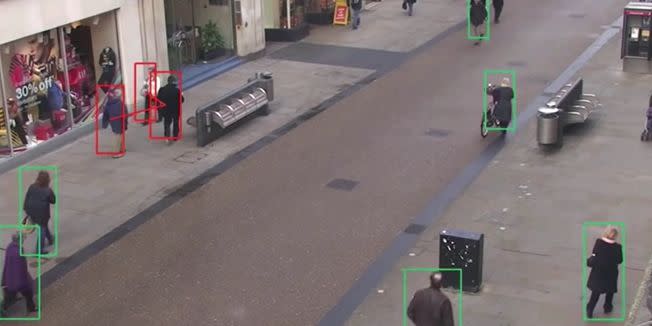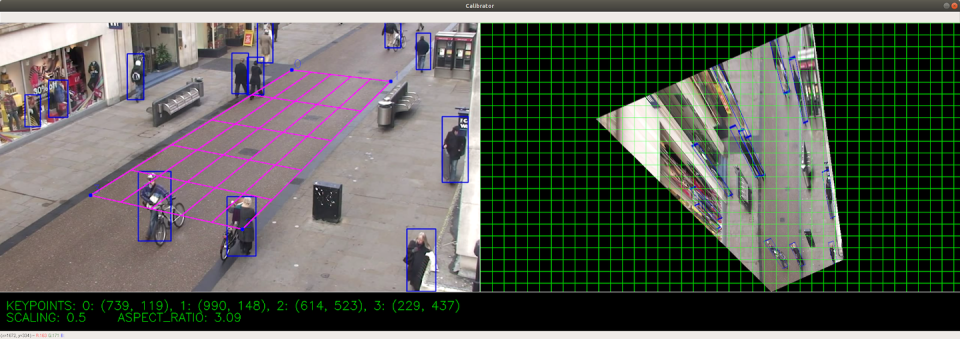How the Coronavirus Could Turn the U.S. Into a Surveillance State

Landing AI has developed a tool that can track people's locations in real time to see if pedestrians are getting too close to each other.
It's meant to enforce social distancing policies that dictate at least six feet of space between people out in public.
While noble in theory, the concept is open to security issues. Plus, video surveillance is strikingly unpopular in the U.S.
Amidst the COVID-19 (coronavirus) pandemic, the world is reckoning with what it means to remain apart. And it turns out we're not so great at following the rules of social distancing.
Enter the machines.
Earlier this month, the startup Landing AI announced a new social distancing tool that uses artificial intelligence to track whether or not people are staying far enough apart in public spaces. It all happens in real time, and the system can even give out verbal warnings if people are potentially opening themselves up to contagion.
This tech is part of a new class of surveillance technology that watches over our shoulders to make sure we leave a buffer of at least six feet between each other in public. Some governments have even used drones to yell at people for breaking quarantine measures.
Are we actually willing to give up some of our privacy in exchange for surveillance systems that could potentially stop the spread of the deadly virus? Probably not—but it isn't stopping companies like Landing AI from pursuing that future.
Landing AI is starting with the workplace. Essential workers in industries like chemicals, pharmaceuticals, and manufacturing still have to show up to the office—albeit, in masks—which increases their chances of contracting SARS-Cov-2, the virus that causes COVID-19. Security cameras are often already installed in labs and warehouses, which could make the transition more seamless.
"[A]t a factory that produces protective equipment, technicians could integrate this software into their security camera systems to monitor the working environment with easy calibration steps," Landing AI says in a blog post. "The detector could highlight people whose distance is below the minimum acceptable distance in red, and draw a line between to emphasize this. The system will also be able to issue an alert to remind people to keep a safe distance if the protocol is violated."
Landing AI takes a three-pronged approach to this surveillance: calibration, detection, and measurement. In terms of calibration, the company must first transform the monocular (single-camera) video stream that most firms have into a bird's-eye view.
To do that, Landing AI takes four points in the frame and maps them to the corners of a rectangle in the bird's-eye view (see below). The video camera owners can then apply that transformation to the entire video stream. This is also when the AI system estimates the scale in the bird's-eye view to determine how many pixels approximate six feet in the real world.

During the detection phase, Landing AI must set up bounding boxes around pedestrians to illustrate if they're practicing social distancing or getting too close to each other. The company used an open source pedestrian detection network and a minimal amount of post-processing to clean up the bounding boxes.
Finally, in the measurement stage, the Landing AI software comes up with estimated coordinates (x, y) for a person's location in the bird's-eye view plane. Anyone below the minimum acceptable distance apart is highlighted in red, and the system draws up a line between the two people for emphasis.
Some companies are already adopting similar technology. Pepper Construction, for example, is using software from SmartVid.io to track workers at an Oracle project site in Deerfield, Illinois.
"The last thing we want is for the governor to shut all our projects down because no one is behaving," Jen Suerth, vice president at Pepper Construction, told Reuters.
In practice, it's questionable how workers will react to such Big Brother-isms. Landing AI emphasizes there's no way its surveillance tech will identify individual people and urges other firms that are doing so to act with "transparency and only with informed consent"—essentially, the opposite of the controversial startup Clearview AI.
But for the offices and warehouses still up and running, state governments have already mandated social distancing measures like Plexiglas partitions; minimal, if any, face-to-face meetings; and staggered shifts and breaks. So Landing AI's software would more or less be a matter of compliance. The real opportunity to quell the spread of SARS-Cov-2 is in the public sphere, as the company's demo video depicts.
This kind of tech would obviously work best in an existing surveillance state, where the infrastructure is already primed and ready. London, for example, is brimming with CCTV cameras—there's one for every 14 people, which breaks down to over 627,000 total cameras. While the U.S. also has loads of cameras, they're mostly relegated to places of business and urban centers like New York City and Chicago.
Landing AI's technology could certainly aid pandemic management, but there's still little policy in place to regulate its use. Plus, there's the risk that companies will continue to use this kind of technology after the pandemic subsides.
The silver lining? It's not a financially viable time to implement an all-new tech solution at scale. So it's unlikely companies in conservation mode will widely adopt surveillance software.
In the meantime, you can always make like this guy and ensure your six feet.
You Might Also Like

